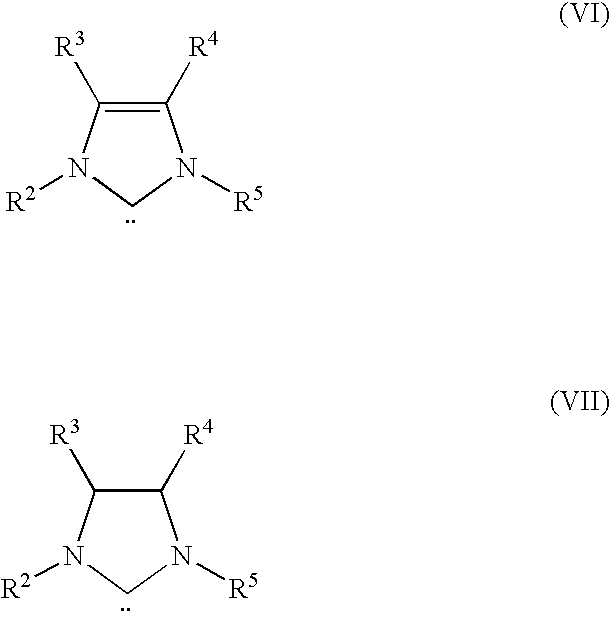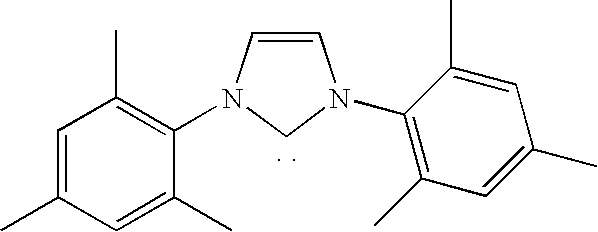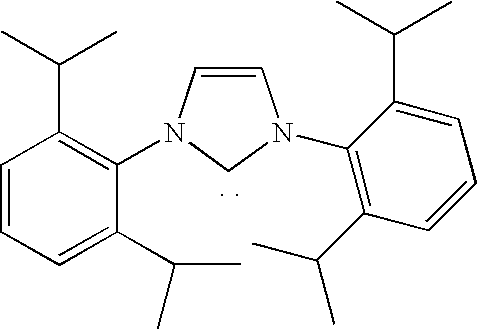Immobilized esterification catalysts for producing fatty acid alkyl esters
a technology of esterification catalyst and fatty acid alkyl esters, which is applied in the preparation of carboxylic compounds, biofuels, fuels, etc., can solve the problems of large amounts of free fatty acids, large amounts of fats and oils unsuitable for human consumption, and inability to convert to biodiesel at lower cos
- Summary
- Abstract
- Description
- Claims
- Application Information
AI Technical Summary
Benefits of technology
Problems solved by technology
Method used
Image
Examples
example 1
Synthesis of Mesoporous Silica (SBA-1 5).
[0076]SBA-15, an ordered porous silicate, was synthesized using an adaptation of the method of Zhao et al. (J. Am. Chem. Soc. 1998, 120, 6024-6036). Pluronic P-123 (4 g) was added to 2 M HCl (125 mL) at ambient temperature (25° C.). The temperature of the mixture was raised to 50° C. After 2 h, the solution was cooled to 40-45° C., and then 8.54 g of tetraethyl orthosilicate (TEOS) was added. Precipitation was observed. The solution was stirred for 22 h at 40-45° C. Then, the temperature was raised to 95° C. After 24 h, the solution was cooled to ambient temperature, and the precipitate was collected and dissolved in 200 mL of ethanol. After refluxing for 12 h, the ethanol solution mixture was cooled to room temperature. The precipitate was filtered and suspended in another 200 mL of fresh ethanol. The mixture was brought to reflux. After 12 h, the mixture was cooled to room temperature. The precipitate was filtered and dried under vacuum for...
example 2
Synthesis of Immobilized Metal Salt Complexes
[0077]Synthesis of ZrOCl2.8H2O and SBA-15 complex: SBA-15 (112 mg) and ZrOCl2.8H2O (129 mg) were mixed in 15 mL of toluene and brought to reflux. After 2 h, the mixture was cooled down to ambient temperature. The solvent was evaporated in vacuo and the residue was washed with toluene (50 mL x 3) and methanol (50 mL×3) and air-dried to give a powder (210 mg). Elemental analysis confirmed the presence of Zr in the silica.
[0078]Synthesis of ZrCl4 and SBA-15 complex: a mixture of ZrCl4 (92 mg) and SBA-15 (112 mg) in 15 mL of methanol was brought to reflux. After 30 min, the solvent was evaporated and the residue was washed with toluene (50 mL×3) and air-dried. Elemental analyses were employed to confirm the structure.
[0079]Synthesis of ZrO2 and SBA-15 complex: similar to the procedure of ZrCl4 above: ZrO2(49 mg) and SBA-15 (112 mg).
[0080]Synthesis of Zr(SO4)2 and SBA-15 complex: similar to the procedure of ZrCl4 above: Zr(SO4)2 (113 mg) and S...
example 3
Catalytic Activity of Metal salt / SBA-15 Complexes
[0091]The ability of the different metal salt / SBA-15 complexes synthesized in Example 2 to catalyze the esterification of a free fatty acid (FFA) was tested in batch reactions. For this, a mixture of oleic acid (0.282 g) and methanol (4 g) was mixed with each of the metal salt / SBA-15 complexes (28 mg). Each mixture was brought to reflux (65° C.). At fixed time intervals, a small amount of the mixture was removed from each reactor. After removal of the solvent, the amount of the product (i.e., oleate methyl ester) was estimated by 1H NMR (see Table 1). The most efficient catalysts were ZrOCl2.8H2O, ZrCl4, Zr(OC4H9)4, and a combination of ZrCl4+SnCl4; each produced nearly 100% yield after a 45 min reaction.
TABLE 1Esterification of oleic acid.Metal saltYield (%)conjugated to SBA-1515 min45 minZrOCl2•8H2O88>99ZrCl485>99ZrO2tracetraceZr(SO4)2tracetraceZrSiO4tracetraceZr(OC4H9)485>99SnCl4•5H2O4565TiCl46377FeCl3•6H2O915ZrCl4 + SnCl489>99
PUM
| Property | Measurement | Unit |
|---|---|---|
| Temperature | aaaaa | aaaaa |
| Temperature | aaaaa | aaaaa |
| Temperature | aaaaa | aaaaa |
Abstract
Description
Claims
Application Information
 Login to View More
Login to View More - Generate Ideas
- Intellectual Property
- Life Sciences
- Materials
- Tech Scout
- Unparalleled Data Quality
- Higher Quality Content
- 60% Fewer Hallucinations
Browse by: Latest US Patents, China's latest patents, Technical Efficacy Thesaurus, Application Domain, Technology Topic, Popular Technical Reports.
© 2025 PatSnap. All rights reserved.Legal|Privacy policy|Modern Slavery Act Transparency Statement|Sitemap|About US| Contact US: help@patsnap.com



